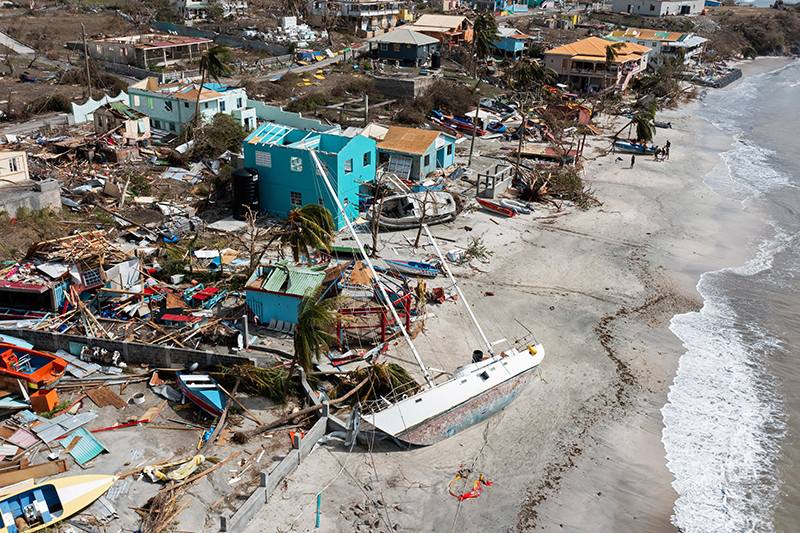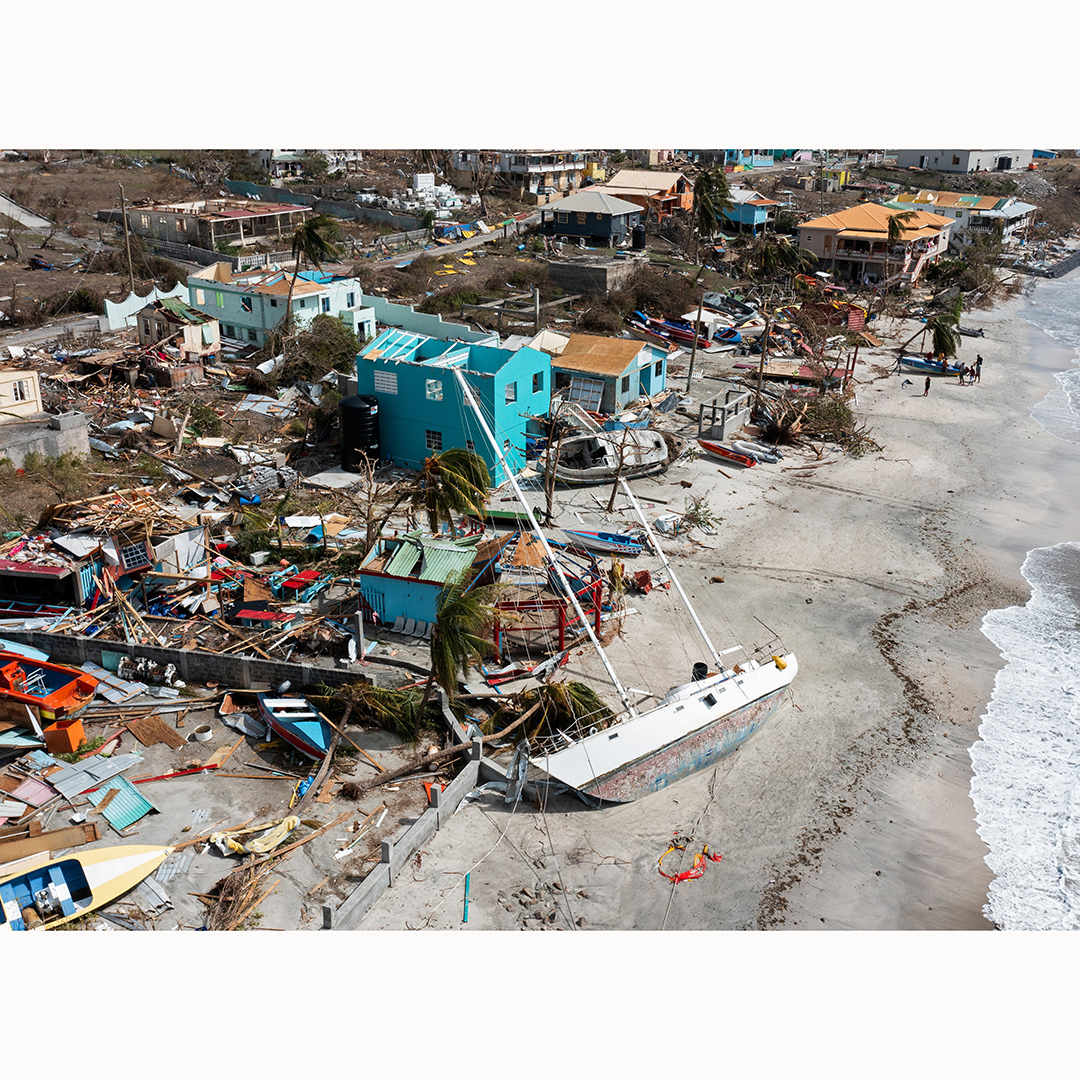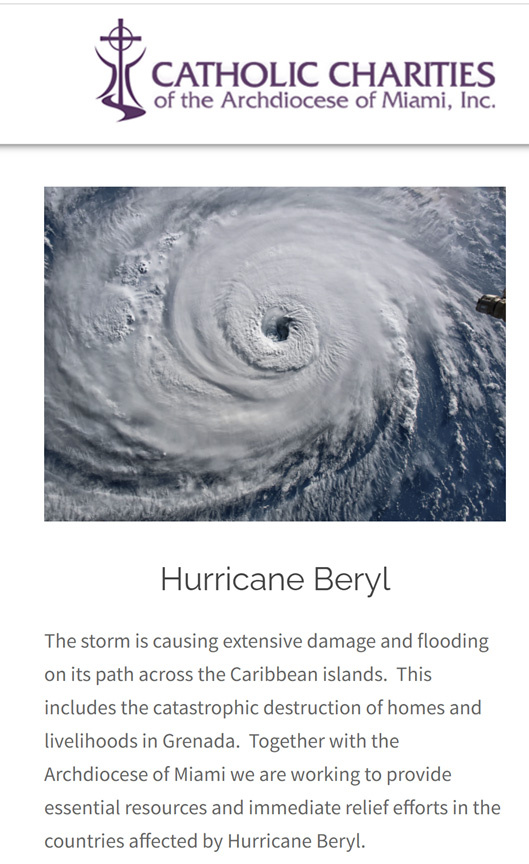By Tom Tracy - Florida Catholic

Photographer: Arthur Daniel
Scattered debris, a sailboat and houses with missing roofs are seen in a drone photograph July 2, 2024, after Hurricane Beryl passed the island of Petite Martinique, Grenada. (OSV News photo/Arthur Daniel, Reuters)
MIAMI | After Category 4 Hurricane Beryl struck the two islands of Carriacou and Petite Martinique, which are part of Grenada and located off the northern coast of South America, on July 1, 2024, Bishop Clyde Harvey of the Diocese of St. George's-in-Grenada arrived by boat on Carriacou Island on July 12 to find a traumatized community and at least two diocesan churches there that suffered catastrophic damage from the hurricane.
Hurricane Beryl was the second named storm of the 2024 season, formed very early in the hurricane season and became the earliest Category 5 hurricane on record in the Atlantic.
Beryl formed in late June in the Atlantic Ocean and impacted Grenada and other Caribbean islands as a Category 4, killing at least 11 people.
Beryl caused significant damage and flooding that also affected Jamaica, the Cayman Islands and Mexico before making landfall in Texas, United States, on July 8, 2024, after being downgraded to a Category 1.
According to Catholic Relief Services, CRS, in Grenada, 98% of buildings—home to some 6,000 people—are damaged or destroyed. Most families there collect rain from rooftops, which is a low-cost way to store drinking water. With such extreme damage to homes, drinking water is now running out.
People in Grenada have described the island as almost entirely homeless—and residents are in urgent need of shelter support, clean water, hygiene supplies, food and other assistance. Especially for families who have lost their homes and assets, immediate safety from the elements is a high priority.
On July 12, Bishop Harvey visited Carriacou, “I went to Carriacou and it rained and rained and rained — Carriacou is normally a place lacking rain, but people had buckets had sitting out and full of water,” said.
The Trinidad-born Bishop traveled there with an Irish missionary priest who had already worked in Carriacou and knew the communities.
“I didn't appreciate the seriousness of the damages there until I arrived,” Bishop Harvey said.
He reported that the diocesan church of Our Lady of the Rosary of L'Esterre had been completely destroyed, with only one wall of the sanctuary remaining, necessitating a complete rebuild from the foundations. Another church, St. Patrick in Hillsborough, Carriacou, had lost only its roof, but an assessment is required to determine if the remaining walls could be used in reconstruction.
“Our Lady of the Rosary Church had been completely flattened — it is a beautiful community and has one of the best choirs on the island. The only thing left standing was one wall of the sanctuary with the Crucifix and the tabernacle. That church will have to be completely rebuilt from scratch," laments the bishop.
Other diocesan teams have already conducted assessments and humanitarian trips to northern Grenada and Petite Martinique, where at least one church reportedly lost part of its roof and sustained other structural damage, he added.
Bishop Harvey credited Catholic Relief Services, Caritas Antilles and the Youth Emergency Action Committee (YEAC), associated with the Episcopal Conference of the Antilles, for their prompt response after the hurricane.
YEAC teams, geared toward engaging Catholic youth in the Caribbean to respond locally in times of emergency, especially after hurricanes, arrived in Carriacou within days of Hurricane Beryl.
“The focus of this ministry is helping them develop their own talents and using those talents in emergency assistance in times of crisis. They went out to Carriacou, set up a camp with help from CRS and did some initial assessments and reported what was needed,” said Bishop Harvey.
Additionally, several Catholic schools and churches throughout the region served and continue to serve as hurricane shelters. A government report from Grenada states that approximately 3500 homes have been affected in St. Vincent and the Grenadines, with some 10,000 people living there with significant damage to their homes.
The personal impact of the storm on the local health staff has hindered operations across the health network. Approximately 1,099 persons are sheltered in 49 shelters in St. Vincent and the Grenadines, according to estimates.
Bishop Harvey noted that the Hurricane Beryl’s early arrival in the season meant that local Caritas preparations were not as complete as they could have been. He acknowledged that emergency supplies and provisions were not as plentiful as they typically are in September and October, but he was grateful for the aid that had already arrived in the region over the past two weeks.
“One of the major challenges now is how do we help with the rebuilding program but also with rebuilding lives – the real rebuilding is rebuilding people’s lives,” he emphasized.
After Hurricane Ivan in 2004, many homes were rebuilt, but the trauma endured from Ivan remained when Beryl arrived, Bishop Harvey said.
He is primarily concerned about the safety of elderly and children in his diocese, noting than some elderly individuals have already been relocated from Carriacou to mainland Grenada.
A team of counselors associated with the Franciscan Institute of the Caribbean made several visits to the most affected areas and explored how to provide long-term psychosocial support in those regions.
That initiative requires funding because it involves bringing staff in and out, “and we have to consider whether we let people stay in Carriacou or do we transport them out (as needed),” Bishop Harvey explained.
The bishop is also concerned about the livelihoods of small farmers and small businesses in places like Carriacou and Petite Martinique.
Simultaneously, the Bishop Harvey has been raising awareness with a spiritual tone in the aftermath of Beryl through his weekly media broadcasts through the diocese's Good News Catholic Communications program on social media platforms.
While attention is heavily focus on the U.S. presidential election, Bishop Harvey said he can't help but wonder if even a fraction of individual political contributions could be redirected to humanitarian and Christian projects.
The Caribbean urgent requires support for Catholic education. "I have a tremendous challenge with Catholic schools (financially)," Bishop Harley acknowledged, expressing hope for future partnerships to rebuild Catholic education in the Antilles.
- If you want to make a donation, click here.


